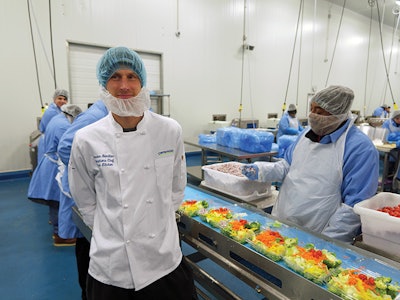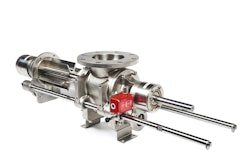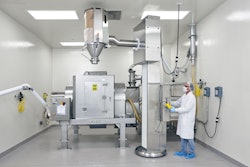In a world where consumers decide where to grocery shop based on prepared, minimally processed, fresh meals, and where to fill up their gas tanks based on the selection of great tasting, fresh sandwiches and snacks, there’s no doubt that the fresh, healthy and minimally processed food movement is no longer a trend. It is now engrained in the American food culture.
ProFood World’s 2017 Manufacturing Innovator of the Year—Caito Foods—is leading the march in the fresh food revolution. Founded in Indianapolis in 1966, the company has grown over the past half-century to supply fresh produce throughout the Southeast, Midwest and Eastern U.S.
Acquired earlier this year by SpartanNash—the nation’s fifth-largest food distributor and the leading distributor to U.S. commissaries and exchanges—Caito Foods and its new Fresh Kitchen processing facility will fuel growth opportunities for the Fortune 400 company’s business in the growing freshly prepared centerplate and side dish categories.
Caito Foods partners with premier growers to provide conventional and organic fruits and vegetables to the marketplace. The company’s Fresh Cut Division provides freshly prepared fruit and vegetable packages including kitchen-fresh ingredients, salad kits and side dishes, and grab-and-go salads and sandwiches.
But bringing high-quality, fresh protein-based meals, sandwiches and other snacks to customers is no easy task. To meet growing market demands, Caito Foods needed an additional facility. Construction of a 149,100-sq.-ft. greenfield plant began in September 2015, and after an aggressive 15-month schedule, the plant was producing meals and snacks by early 2017. The new Fresh Kitchen facility was carefully designed to fit into Caito’s existing campus to take advantage of the company’s fresh produce facility for maximum product quality and freshness for its meals, salads and snacks. Synergies are found not only in support functions, but in transportation savings as well by combining delivery of goods to retail stores from both facilities.
Designed and constructed by ESI Group USA, the plant includes clean room-environment production areas that are refrigerated and high levels of food safety and sanitary plant design. “The main challenge in designing the facility was using an existing parcel of land on Caito’s campus,” says Tim Nguyen, regional vice president of ESI Group. “Without sacrificing any production square footage, a full two-story office was included, utility mezzanines in the tank and chemical rooms were added, and a box mezzanine with gravity-fed conveyors was designed for packaging material delivery. All of this gave Caito Foods the flexibility to expand production space, add additional food products and arrange processing lines to meet future growth.”
Armand Angeles, Caito Foods’ vice president of food safety, is the brainchild behind the new plant’s design. The facility features an open area to stage product presentations along with an adjacent observation deck for customers to view the entire production facility without stepping a foot inside. “The customer experience is very important to us. We really wanted this area to provide a positive, memorable interaction for our guests,” Angeles states. The main tasting room opens directly to the R&D kitchen, where customers can work directly with Caito Foods’ chefs.
Expandability and flexibility were also very important to the facility’s success. The plant features an additional, unfinished 15,800-sq.-ft. area to accommodate market changes that may exist over the next five years. “We built flexibility into the infrastructure so that we can make very quick, easy changes based on customer needs,” says Caito Director of Engineering Dustin Varvil.
Divide and conquer
Two entrances to the building divide the raw and cooked sides, segregating process flow. In reality, the facility features two side-by-side processing plants.
Raw protein products are received into the raw dock, where they are then prepped. The red (raw) floor features vacuum tumbling equipment for various marinade infusions and the grinding operation. A loading station, hood and conveyor grill cook protein products, which flow through the wall and on to the blue floor ready to eat.
On the raw floor, a utility distribution system (UDS) “allows us to bring all the utilities we need for the equipment into a centralized area,” says Varvil. “We are able to plug and unplug new equipment without having to run new utilities.”
The plant design also left ample space for new equipment to be installed. “It doesn’t matter whether it needs water, airflow, etc., we have all the utilities in place,” Varvil states. “When we put together this project, we had a Day 1 plan, a Day 1,000 plan, and Day 10,000 plan, which allows us to put in more equipment, refrigeration or airflow if needed, for example. We looked at it from the standpoint of being able to make changes, but not knowing what the changes will be.”
Caito worked with a consulting firm to help it design the UDS system to be flexible enough to help grow its business. Caddy Corporation custom-designed hood machinery and the UDS equipment.
Food cooked on the Baxter rack oven goes to the blast chiller and then is taken to the RTE or blue floor. Soon, more cooking and preparation equipment will be easily installed as product demands grow.
“When you are running seven days a week, downtime is difficult to come by,” says Angeles. “Being able to get new equipment installed in 10-12 hours will provide minimal disruption to production.”
A foundation of food safety
Avoiding cross-contamination was paramount to the project. Floor foamers, activated every two minutes, sanitize feet and other floor traffic as people and equipment move through the facility. Under-floor plumbing was designed to differentiate between the office, raw protein and process waste and features stainless steel floor drains. Fast Track flooring sloped .25 inches per foot throughout the plant was provided by Dur-A-Flex. The urethane floor with silver nitrate installed in the assembly room inhibits bacteria growth. Internal walls and ceilings are constructed with insulated galvanized metal panels with a special finish to allow proper washdown.
According to ESI, the process area includes multiple stations that provide cleaners, sanitation agents and 130ºF water to allow safe and efficient daily room deep cleaning. These stations are fed from a specially designed, chemical room that allows “no-touch” chemical deliveries, automatically mixes the concentrates to the desired dilution, and delivers these solutions to the processing room without human contact.
Clean-in-place capability is installed for most major equipment, with process controls on all cooking and packaging equipment, integrated on a data acquisition network platform.
The separation of raw and RTE process sides also eliminates the ability for employees to go from the blue side to the red side or vice versa. To avoid contamination problems, employee access is only allowed through ID card readers.
All incoming ingredients bag exteriors are spray-washed in a sanitary environment before moving to the assembly processing area. Airflow in rooms is pressurized from high-risk to low-risk areas to ensure no airborne contamination. The hygienic make-up air unit in the cooking areas is capable of providing 49,000 cubic feet per minute of airflow, which is controlled by multiple variable frequency drives and pressure sensors.
Enhancing sanitary plant design, piping and other equipment are placed one-inch off the wall. Crevice-free wash-down equipment is often kept on wheels, not only for flexibility but for efficient clean-in-place operations. The facility also features special rooms for waste storage, so employees are not continually moving trash throughout the facility. Refuse is stored and removed once a day.
Other precautionary steps taken to help control potential pathogens associated with raw proteins are the boot washers. When employees exit the raw side plant floor, they walk through a boot washer and then hang their boots on a dryer. This ensures boots are clean and ready to be sanitized upon reentry to the plant floor.
Frequent line changeovers and the accompanying requisite chemical wash-down procedures are carefully monitored by quality assurance staff. To allow associates to clearly differentiate employees and communicate information to the proper staff, red hats are worn by QA monitors, and white hats are for line operators. Employees donning green hats may not touch product, and supervisors are indicated by blue hats.
The parallel facilities also provide complete separation for all support systems. This includes separate quality labs, maintenance shops, breakrooms and employee rest rooms. “Our focus was to engineer out employee mistakes leading to compromised products,” says Varvil. “The foundation of this building is food safety. This was job one.”
Farm fresh goods
Fresh produce is received at Caito’s existing facilities from growing regions three times per week and processed within two to three days, then sent to the new Fresh Kitchen facility.
According to Angeles, distribution to retail outlets is not more than a day’s drive to ensure freshness. Direct store delivery is the next day, with further distribution no more than two days after.
“Food safety continues to drive supermarkets away from making their own fresh foods,” says Angeles. “Caito provides consistency in labor, procedures, quality and overall food safety. We are producing all these products for 1,000 different stores. If individual supermarkets were doing this, they’d have 1,000 different people doing it at 1,000 different locations, making consistent quality and food safety difficult to control.”
Cross-training employees on multiple lines maximizes flexibility and the ability to meet seasonal demands, especially around major holidays.
At press time, the plant was operating four lines for non-cooked food and two for cooked food in the 34-36ºF assembly room. The room has a current state capacity for up to 12 lines for future growth. Current product offerings include wraps, pizza, sandwiches, salads, sub sandwiches, parfaits, and pinwheels precisely cut by Grote ultrasonic cutting equipment.
To increase line efficiency, the facility includes a mezzanine over the packaging room. When packaging is requested from the assembly room, it is delivered by a spiral conveyor, moves through a sanitary wash and is then fed into the assembly room.
In the cooking area, a large hood system reduces employee exposure to steam when opening equipment. The hood has heat sensors that keep fans running at the needed velocity on a consistent basis, providing major energy savings.
One major point of differentiation for Caito Foods is the installation of custom grill machinery from Barron Industries that cooks and places real grill marks on both sides of protein products such as chicken.
The 10,000-sq.ft. foot kitchen features two UDS systems, rotating ovens and blast chilling. The UDS provides steam, gas, water, reverse osmosis (R/O) and tempered water in a central location, so new equipment can be plugged in and ready to go. High-pressure steam brought in by a steam generator allows Caito more flexibility and brings 200 gallons of water up to boil in about 15 minutes. Seven different R/O water systems throughout the facility provide purified water to the equipment.
The water chiller brings water in at a rate of 25 gallons per minute to multiple pieces of equipment, reducing preparation time after cooking. The mixing area has multiple different mixers for proteins such as tuna, seafood or chicken salad. Meat and cheese slicing is performed in a special room on a Grote cutter.
High levels of food safety and quick changeover were achieved by installing Dorner hygienic conveyors that are easy to clean, break down and reassemble.
Customizable packaging is available for each of Caito Foods’ customers including small retailers, major supermarkets and club stores. A few months after start-up, the plant is already running 110 SKUs with automated package labeling equipment.
The finished goods storage room has no racking and is only 8,000 sq. ft. because Caito Foods does not want to store goods. “If it’s not out of here in one day, it just becomes waste,” explains Varvil.
The facility also features a docking system to bring in trucks with rollup doors to seal them, but can also accommodate trucks with barn doors. Some trucks can take longer than others to back into the dock, and the new systems keeps trailer temperatures at the proper level. The dock is expandable to five more bays as the company grows. “Flexibility is key for this industry,” states Varvil. “If you don’t build in flexibility into this type of plant, you will have a hard time keeping up with your customers’ changing needs.”
Engaged employees
Associates discuss key performance indicators in the war room, as well as sort out any issues, and meet with staff from human resources, customer service, quality assurance, warehouse and production twice a day. In-house continuous improvement engineers are constantly reviewing potential process improvements via sensors on all lines for tracking overall equipment effectiveness and real-time monitoring of processes. Caito Foods has line blueprints for the location of every employee for every SKU. If an employee is absent, management knows which current employee should move around the line to least affect efficiency.
Led by Ian Orr, director of operations for Caito Foods Fresh Kitchen, the company has overcome challenges in employee engagement found at many food and beverage processing plants.
Pleasant employees say, “Good morning” and greet all visitors. A lunch is provided to all associates every day at no cost to the employee. During PFW’s visit, a “breakfast for lunch” menu included eggs, grits, waffles and carrot cake. Marinated, blackened chicken breast, alfredo pasta and spring mix salad were offered on another day.
Tremendous improvement in turnover has been achieved with simple things like providing a great lunch, says Orr, who previously was a chef with Darden Restaurants and worked in airline catering management at JFK Airport for 36 different airlines. In fact, he says overtime has dropped by 50 percent.
“Employee engagement is extremely important, as the steel and mortar that built this plant never made a pound of product,” adds Varvil. “It’s the people here that make it happen.”
In the offing
Caito Foods currently distributes products to 24 states and is producing 16,000-20,000 fresh products per day. It expects to grow to 140,000 units a day when at full operation, says Orr.
“The value add is supermarkets can gain floor space for retail sales by letting a company like Caito Foods take over their freshly prepared meals, sandwiches and snacks,” he states.
Product quality and consistency are also important for major supermarket chains. An Italian sub purchased in an Indiana store should look and taste exactly like one bought in a Kentucky store. After all, “that’s what made McDonald’s successful,” concludes Orr.
In fact, the fast food giant recently announced it would be using fresh beef in made-to-order burgers starting next year.
For the future, Caito Foods is working on meal kits, breakfast meals, dinner entrees for two or four people and restaurant-quality ethnic dishes and flavors that appeal to consumers but that are well below restaurant prices. Very soon, the company will install modified atmosphere packaging (MAP) equipment to supply smaller retailers who need longer shelf life. The MAP machinery will allow the company to further extend its delivery reach and provide for more customer locations.
Just a few months after start-up, the new facility is already seeing an almost 20 percent improvement in efficiency and operations compared to the old facility. And with the SpartanNash acquisition announced earlier this year, Caito Foods has just scratched the surface of the burgeoning fresh foods market.
























